Join More Than 50,000+ Subscribers and get latest camera news and rumors
NEW CAMERA VIDEOS ON YOUTUBE
|
By admin, on June 10th, 2023
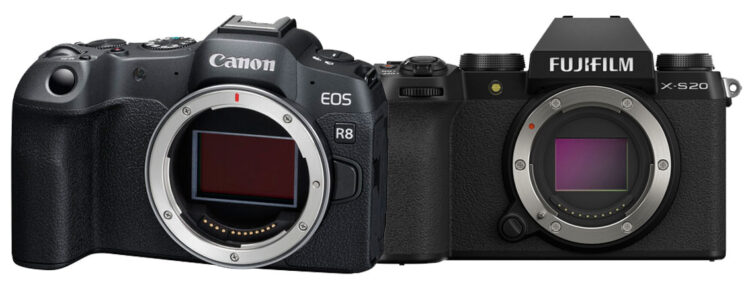
1. Sensor resolution and sensor size
The Canon R8 camera features the same sensor that we have seen in the R6 Mark II, the full-frame 24-megapixel Dual Pixel CMOS autofocus sensor of the 2nd generation. Inside the Fuji X-S20 camera, we have an APS-C sensor of 26 megapixels.
As usual, the larger pixels tend to capture more light than the smaller ones. We have a Fuji APS-C sensor with a denser megapixel network, and in Canon’s full-frame sensor, we have only 24 megapixels. But at the same time, we also have to consider that there is a technological difference. Fuji is using a BSI sensor and Canon is using an FSI CMOS sensor.
Fuji X-S20 vs Canon R10 – The 10 Main Differences
| Model Name |
Canon R8 |
FUJIFILM X-S20 |
| Sensor Resolution |
Effective: 24.2 Megapixel |
Effective: 26.1 Megapixel |
| Image Sensor |
35.9 x 23.9 mm (Full-Frame) CMOS |
23.5 x 15.6 mm (APS-C) CMOS |
| Image Stabilization |
None |
Sensor-Shift, 5-Axis |
| Built-In ND Filter |
None |
None |
| Capture Type |
Stills & Video |
Stills & Video |
This technology difference may make an impact on image quality, but image quality can also be affected by the laws of physics.
36.00µm2 vs 14.12µm2 approx 154% larger pixel area
So the big question is whether the 26-megapixel sensor will perform better in low light due to the BSI sensor technology or if a full-frame sensor with a 24-megapixel resolution will perform better. Let’s find out in the test.

At ISO 25600, it is very clear that Canon R8 photos are preserving more detail compared to the Fuji X-S20. As you can see in the image, the color blocks are very well maintained and the details are preserved.
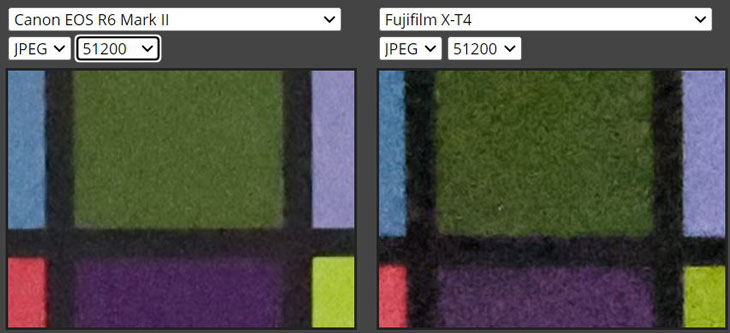
At ISO 51200, the Fuji X-S20 camera again fails to impress, with Canon R8 preserving more details even at higher ISOs compared to Fuji’s X-S20.
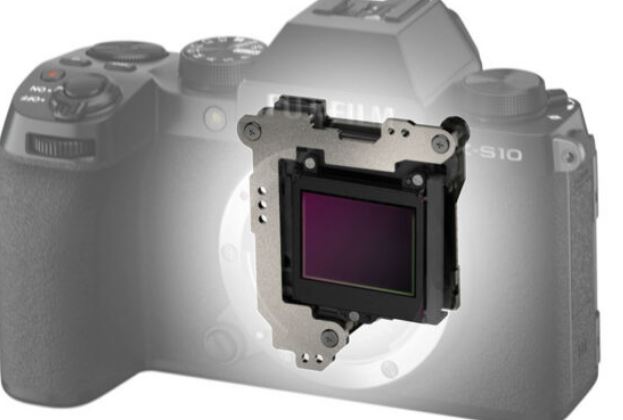
2. Sensor shift image stabilization
Fuji xs20 camera features a sensor-shift image stabilization system which is completely absent in Canon R8. One of the biggest advantages we have is the ability to use slower shutter speeds in low-light environments, resulting in better light efficiency, more light to the sensor, and hence cleaner images.
So in practical situations, if one knows how to use the image stabilization system properly in combination with the shutter speed of the camera, they may have better output than a full-frame camera without an image stabilization system.
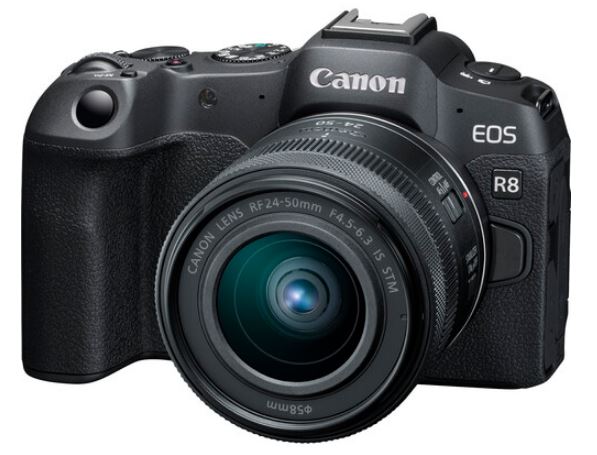
3. AUTO FOCUSING SYSTEM
| Canon R8 |
Fuji X-S20 |
|
Canon R8 AF Points on Sensor: 4897
Number of cross-type focus points: 1053 ( AF frame zones)
Class Leading AI AF technology coming straight out from Canon R3 AF system
MAX Brust speed 40 FPS @ full Res. AI/AF support (JPEG only)
MAX Brust speed 30 FPS @ full Res. AI/AF support (JPEG + cRAW) |
Fuji X-20 AF points: 425 HYBRID
Uses the Same AI AF as of Fuji X-H2s Camera
Now in auto mode, the camera can detect and track drones and insects too.
MAX 30 FPS with 1.5x CROP AI/AF support
MAX 20 FPS @ Full Res. AI/AF support (RAW + JPEG) |
From this specification analysis, it is obvious that the Canon R8 camera features an advanced autofocus system. For sports shooters or wildlife photographers, it is recommended to get the Canon R8 camera with lenses like 100-400 (Budget zoom). But if you are a daily life photographer, event shooter, wedding photographer, street shooter, portrait or fashion photographer, you will actually feel no issue while working with the autofocus system of the Fuji X-S20.
So for sports and wildlife photography, it is more recommended to get the Canon R8 camera, and for others, you can buy either of these two cameras.
4. Weather sealing in Canon
The Canon R8 camera is a weather-sealed camera, so it allows you to work in adverse situations where you may feel a bit worried about taking out your camera from your bag. But at the same time, the Fuji X-S20 is not weather-sealed, so you have to keep this in mind before buying either of these two cameras.
5. Double battery life of Fuji X-S20
With the Fuji X-S20 camera, you are getting approximately 750 shots per charge since, for the first time, they have used a professional-level battery in a mid-range APS-C series camera. However, you have to feel some limitations because the battery life of the Canon R8 camera is limited to 290 shots in a single charge. For those who mostly shoot outdoors, such as travel photographers, they must keep an extra battery pack for Canon cameras. The good thing is that both cameras allow you to charge via USB even when you are shooting
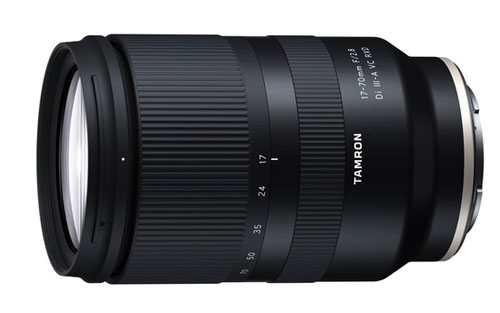
Get Tamron 17-70mm RXD Lens form Fuji X-S20 Camera – AMAZON.com | B&H Store
6. Open lens mount support:
The Fuji X-S20 camera has open lens mount support that Canon R8 doesn’t have. As a result, the availability of lenses in Fuji X mount is huge and at the same time, they are affordable when compared with Canon full-frame lenses that you have to buy with the Canon R8 camera.
So if you are interested in the Canon R8 camera, you have to keep an extra budget for collecting all the essential lenses for your camera. Otherwise, while working with variable aperture kit zoom lenses, you will never achieve the optimum image quality of the camera
So which camera you should buy as a photographer?
Yes, you can buy the Canon R8 camera in 2023, but you have to keep a few things in mind.
- The camera does have a full-frame sensor, resulting in better low light performance. But at the same time, you have to mostly buy OIS lenses to have proper output since the camera body doesn’t have any sensor stabilization system.
- The biggest issue that I see is the locked lens mount of Canon, so we have limited options at a higher price range. For lenses, you have to keep your budget at a different level so you can buy the set of lenses you actually require for your work.
- And the biggest advantage that you will have in your hands after having the Canon R8 camera is a class-leading autofocus system directly coming from the Canon R3 flagship model. This not only helps for still shooting but also incredibly helps for capturing videos.
Should you buy the Canon R8 camera in 2023?
So if you would like to buy the Canon R8 camera, there are only two things that affect me before directly recommending it to you. The first thing is the locked lens mount and the other thing for a photographer is the lack of an IBIS mechanism. For this, you have to keep a bigger budget and for the lack of an IBIS mechanism, you have to follow some rules like the shutter speed rule that you should keep while using different focal length-based lenses. So you will manage to get some sharp output from this camera. Otherwise, it’s an excellent camera at this price range.
So we have already discussed the still part of both the camera now discuss the video part
7. Best Cameras for capturing videos – Canon R8 vs Fuji X-S20
The Fuji X-S20 camera offers 6K video recording in an open gate format. Now we all know that nowadays 3:2 format videos are not that usable. With the Fuji X-S20 camera, you are also able to record 5.2K videos in the 16:9 standard format. Fuji is the only camera that offers 5.2K video recording in this price range with full-time autofocus support from third-party lens makers.
So these two advantages are completely absent in the Canon R8 camera.
Now let’s talk about the common strength of both cameras in video mode. The Canon R8, as well as the Fuji X-S20, both allow you to record 4K videos up to 60 frames per second uncropped. You can record 4K 60 FPS video in 4:2:2, 10-bit format inside your camera. Both cameras offer you the use of their C-Log and F-Log modes to extract the maximum out from the video mode.
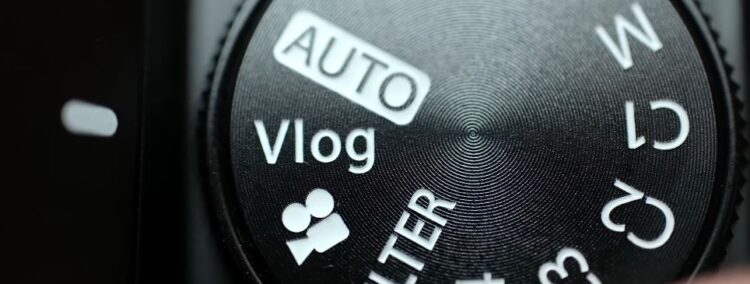
8. Dedicated VLOG Mode
Now let’s talk about a dedicated Vlog mode and more dial present on top of the camera. Fuji engineers worked hard to impress the new generation of content creators and for those, they have not only placed a dedicated Vlog menu on top of the camera but they have also designed a brand new user interface for content creators or those who are coming straight out from a smartphone.

In the new content creator menu, you will easily find the product showcase mode, face tracking priority mode and in different blocks of the content creator menu, it’s very easy to operate the camera and to switch to different modes which are not present right now in the Canon R8 camera.
9. IBIS for video and content creation
Finally, in video mode, we are also having the support of a mechanical image stabilization system in Fuji so that would be a great help when you are working and creating content or shooting cinematography with your camera. The IBIS mechanism will help you a lot in capturing stable footage from your camera.
Again, an open lens mount is one of the biggest factors to recommend Fuji over Canon right now. You have a huge range of lenses to select from which includes wide-angle lenses.
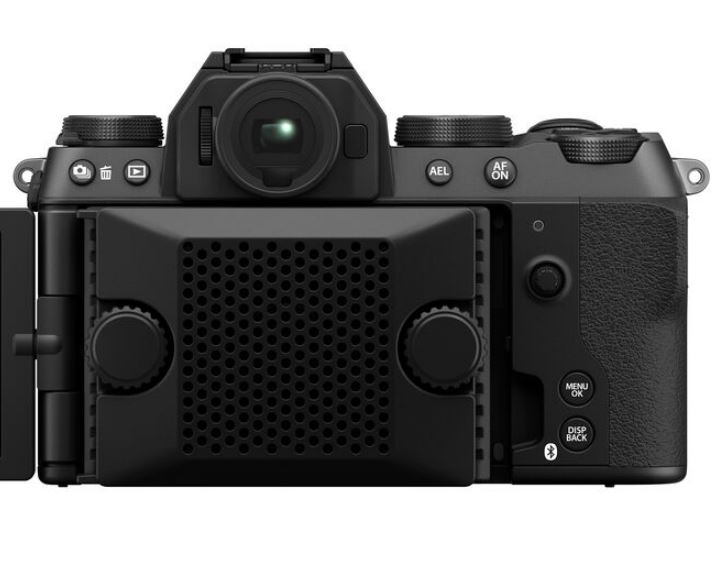
10. External fan
With the Fuji X-S20 camera, you get an option to add an external fan. So in case it overheats when you are shooting in the summer months of June and July, the external fan will double the shooting time length of your camera whether you are shooting in 4K or 5.2K. No such extension is available in the Canon R8 camera although we didn’t receive any major overheating issues related to it.
Let’s talk about which camera is best for videographers, cinematographers, and content creators.
Best Camera For videographers and cinematographers,
Both cameras are highly usable. Specifically, if you are working in an uncontrolled light environment, then you might have the advantage of the Canon full-frame sensor. The camera is capable of recording 4K 60fps videos and due to the large pixels, you will have slightly better low-light performance when compared to the APS-C crop sensor of the Fuji camera.
However, there are two disadvantages.
- One is the absence of an image stabilization mechanism that restricts its handheld use while shooting videos.
- The second disadvantage for videographers is the absence of a proper lens range in your budget.
Why you should prefer the Fuji X-S20 over the Canon R8 for videography and cinematography?
- The big reason to buy the Fuji X-S20 camera is its ability to record 5.2K videos at 16:9 format at a rate of 30 frames per second.
- Despite having an APS-C CMOS sensor, the overall bitrate is 360 Mbps which is a bit more than Canon R8’s 340 Mbps. This directly means you are getting more color information resulting in enhanced video quality. The only disadvantage that we have discussed is that you may face some low light disadvantages due to the limited APS-C sensor size. But if you are shooting in low light, it’s recommended to use Fuji’s F-Log2 (claim to have 13 stops of DR) to extract the maximum quality possible from a given scene.
- The biggest known advantage while using the X-S20 camera is the availability of a huge range of lenses from third-party lens makers.
- presence of an image stabilization system that helps you get stable footage on the move and at the same time,
- the ability to add an external fan to double the recording time.
Best camera for content creators at this price range:
The Fuji X-S20 camera is the best camera we know for content creators at this specific price. Now, Fuji’s autofocus system is much improved and it features multiple autofocus modes for content creators. At the same time, we have a dedicated content creator menu that you can operate efficiently, and as usual, there is a range of lenses for you. More or less, the X-S20 has now become the best and most highly recommended camera for content creators.
Get Canon R8 Camera from Amazon and B&H Store
Fuji Film X-S20 – Camera $1299 [Body Only B&H] [Amazon.com] | 15-45mm Lens $1399 [B&H Store] [Amazon.com]
By admin, on June 8th, 2023

The latest news about Canon R1 surfaces all over the web. Take a look at the important set of specifications coming out from the rumor mill.
Canon R3 Design
According to the sources of the rumor mill, Canon R1 will have a similar body design as the Canon EOS R3.
Large Display Unit of 4 inch?
There will be a large display panel on the backside of the camera, so rumors are expecting a four-inch display screen on a professional-grade photographer’s camera. Since for Cinematographers we already have a separate line of cameras.
45 Megapixel Resolution
The resolution of the camera is rumored to be around 45 megapixels, possibly the stacked version of the Canon R5 sensor.
Class Leading EVF
The viewfinder is said to be of the highest resolution in the Canon lineup, so we can expect a 9-megapixel viewfinder for the first time to be introduced inside Canon.
Global Shutter
Global Shutter is understandably far away for Canon, but yeah, the rumor mill is still speculating. So let’s hope we see at least technology similar to a global shutter or even a sensor with a fast readout speed that captures images without any significant rolling shutter effect.
Dual CFexpress card slots
The camera will have dual CFexpress card slots and one of the sources also said that at least one of the slots is Type-C. So it is kind of a mixed bag and we have to wait for more clarity
NEW Autofocus System
Rumor Mill is speculating on the arrival of the QPAF AF system inside Canon R1.
Cinema EOS Video Features
Team of Cinema EOS working on R1 to develop its high-grade video feature
Canon R1 Arrival Date
Paris Olympic games begin in July of next year
Take it with a grain of salt, since these are not confirmed sets of specs coming out from reliable sources.
Get LIVE RUMORS –> FACEBOOK | TWITTER | INSTAGRAM to get live news + Canon rumors 24X7
source CR.com
By admin, on June 8th, 2023
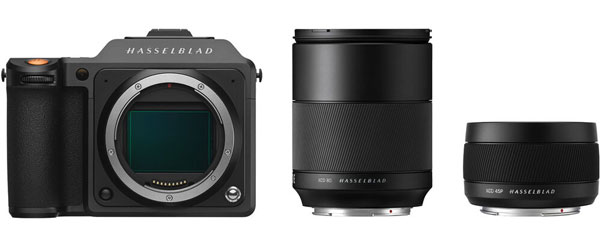
Hasselblad announced today a new portrait kit for photographers, including an X2D100c body alongside XCD 1.9/80 + XCD 4/45P lenses.

Hasselblad New Portrait Kit
INTRODUCING THE HASSELBLAD X2D 100C LIGHTWEIGHT PORTRAIT KIT, UNLEASHING THE POWER OF STORYTELLING THROUGH PORTRAITS
The Hasselblad X2D 100C Lightweight Portrait Kit features two exceptional lenses, the XCD 1,9/80 and XCD 4/45P, providing photographers with a comprehensive set of professional tools specifically designed to capture compelling portraits.
CREATE PORTRAITS THAT TELL A STORY
Designed to empower photographers to create portraits that truly tell a captivating story, the Portrait Kit includes Hasselblad’s flagship mirrorless medium format camera, the X2D 100C, along with two outstanding lenses, the XCD 1,9/80 and XCD 4/45P. With the combined power of the X2D 100C and the versatility of these lenses, photographers gain access to a wide range of portrait shooting options in various scenarios, allowing them to capture powerful, narrative-driven imagery.
UNFOLDING A NEW CHAPTER OF IMAGING X2D 100C
With the Hasselblad X2D 100C Lightweight Portrait Kit, photographers are introduced to a new era of imaging possibilities. At the heart of this extraordinary kit lies the X2D 100C, boasting a remarkable 100-megapixel medium format BSI CMOS sensor. This sensor, combined with the innovative Hasselblad Natural Colour Solution (HNCS), ensures that skin tones are faithfully reproduced, mirroring the way the human eye perceives them in both RAW and JPG photos. With 16-bit colour depth, photographers have expanded flexibility in post-processing, enabling them to push the boundaries of their creativity.
To capture crisp and steady handheld portraits, the X2D 100C features 5-axis 7-stop in-body image stabilization (IBIS). This powerful stabilization system compensates for camera shake, allowing photographers to confidently shoot in low light conditions or at slow shutter speeds, resulting in sharp and detailed images.
The X2D 100C takes autofocus to new heights with Phase Detection Autofocus (PDAF) technology. This advanced autofocus system delivers swift and precise focusing at the press of a button, ensuring that every portrait is perfectly captured, even in dynamic shooting situations.
To accommodate the storage needs of professional photographers, the X2D 100C is equipped with a built-in 1TB SSD, providing ample space to store over 4600 RAW photos. This generous storage capacity empowers photographers to capture high-speed, large-batch, and high-quality portrait sessions without the worry of running out of storage space.
Both lenses included in the kit, the XCD 1,9/80 and XCD 4/45P, feature an integral central shutter, offering exposure times ranging from 68 minutes to 1/2000s with full flash synchronization. This versatility allows photographers to explore their creativity even in challenging mixed-lighting scenarios, seamlessly blending artificial flash and natural daylight to achieve stunning portraits.
WIDE-APERTURE PORTRAIT XCD 1,9/80
The XCD 1,9/80 lens is a medium format wide-aperture autofocus lens that is designed to produce breathtaking results that center resolution and color accuracy. Crafted with an advanced and intricate optical design, coupled with creative calibration technologies, the XCD 1,9/80 lens delivers exceptional optical performance, ensuring stunning image quality even at its widest aperture of f/1.9.
The XCD 1,9/80 lens excels at creating a mesmerizing bokeh effect, creating graceful and smooth transitions between the sharp areas in focus and the softly blurred periphery. Additionally, when used with the X2D 100C camera, it unlocks the full potential of the 100-megapixel sensor, striking the perfect balance between sharp, in-focus areas and beautifully rendered bokeh.
ENVIRONMENTAL PORTRAITS WITH EFFORTLESS GRACE XCD 4/45P
Complementing the XCD 1,9/80, the XCD 4/45P is an ultra-lightweight and compact medium format autofocus lens is specifically designed for capturing portraits in narrow spaces. With its 36mm equivalency, this lens offers flexibility in composition and enables the inclusion of contextual elements, adding depth and narrative to portrait photography. Despite its compact size and weight[1], the XCD 4/45P boasts an exceptional optical design comprising seven elements in nine groups, including two aspherical elements. The result is state-of-the-art visual performance within compact dimensions, enabling the X2D 100C to capture breathtakingly high-quality imagery.
The Hasselblad X2D 100C Lightweight Portrait Kit has an MSRP of EUR €13,489 including sales tax and USD $13,049 excluding sales tax. It is now available to order immediately.
By admin, on June 3rd, 2023
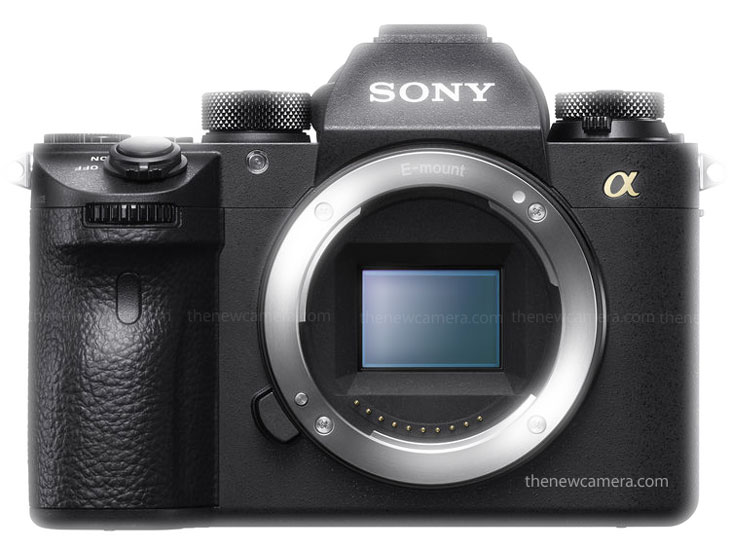
Take a look at the set of information we have related to the upcoming Sony a600 camera
- The new updates include that the A6700 camera sensor doesn’t have DRAM. This is quite obvious since the upcoming Sony A6700 camera is rumored to use the same sensor that we have seen in the Sony FX30 camera and the sensor of FX30 is not a stacked CMOS sensor. Only a stacked CMOS sensor uses a DRAM chip alongside the sensor to speed up the processing speed.
- The second piece of information we are getting from a different source of the rumor mill is that the Sony A6700 camera matches the size of the Sony A7C, approximately 4mm higher and 3mm longer, excluding the grip.
- The third and most important information is that the camera is coming on July 12th alongside a 70-200mm lens. So that’s really very interesting news that not only will there be a camera, but we will also have a brand new G Master telephoto zoom lens from Sony
Sony A6700 Expected Core Specification
- 26.1MP APS-C BSI CMOS Sensor
- BIONZ XR & AI Processing Unit
- AI-Based Real-Time Tracking AF System
- UHD 4K up to 60p (uncropped)
- S-Cinetone
- S-Log3, 4:2:2 10 Bit internal
- 5-Axis Image Stabilization
- updated Quad-VGA OLED Tru-Finder EVF 3.69m-dot resolution for bright, clear viewing in high detail
If you’re new here, let me clarify that we published the rumored set of specifications for the upcoming Sony camera back in April 2023 and the rumored set of specs now seems to be 100% true. You can look at it again here. But the big question raised is whether the Fuji XS20 camera has killed the APS-C camera competition by including 6K open gate recording and 5.2K recording at 16:9 standard format in a mid-range APS-C camera body.
Now, as we all know, the Sony A6700 camera is rumored to use the same 26 MP BSI CMOS sensor. Yes, the only difference is that the Sony sensors are Bayer pattern-based and Fuji’s are X-Trans pattern-based, but both are 26 MP BSI CMOS sensors.
Fuji X-S20 vs Canon R10 – The 10 Main Differences
Fuji X-S20, Sony’s A6700 biggest fear?
The Fuji XS20 camera raised the competition bar to the next level. The camera is able to record 6K and 5.2K, but will the upcoming A6700 camera remain limited to 4K 60p recording (according to the rumors we have from rumor mills) or will it feature 6.2K open gate and 5.2K 16:9 format recording to compete against the Fuji XS20?
Fuji already included Sony’s most popular log camera menu in their camera system that includes product showcase mode and face tracking mode simplified in a content creator menu inside the XS20 camera. If Sony fails to achieve the video resolution that the XS20 camera already offers, it will be a big failure for Sony and it may lose a new consumer base since even Fuji has an open lens mount and advanced autofocus system inside XS20.
Follow us on our social pages FACEBOOK | TWITTER | INSTAGRAM, If you have time –>see more Sony Alpha Rumor
source SAR
By admin, on June 2nd, 2023
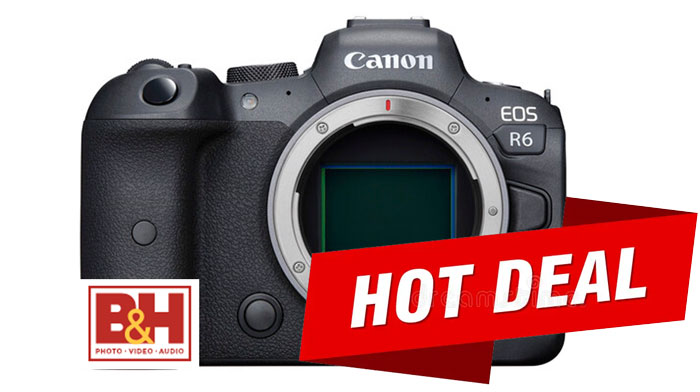
We have some BIG discounts running on Canon R6 cameras and Lenses. The Canon R6 Deal Price is $1599 ONLY for a limited period. Use our link below to jump directly into the deals page.
Get LIVE RUMORS –> FACEBOOK | TWITTER | INSTAGRAM to get live news + Canon rumors 24X7
By admin, on May 31st, 2023

According to the latest rumors, Sony A6700 Announcement on July 12, 2023. The camera is rumored to feature 26.1MP APS-C BSI CMOS Sensor, take a look at the detailed specification below
Sony A6700 Expected Core Specification
- 26.1MP APS-C BSI CMOS Sensor
- BIONZ XR & AI Processing Unit
- AI-Based Real-Time Tracking AF System
- UHD 4K up to 60p (uncropped)
- S-Cinetone
- S-Log3, 4:2:2 10 Bit internal
- 5-Axis Image Stabilization
- updated Quad-VGA OLED Tru-Finder EVF 3.69m-dot resolution for bright, clear viewing in high detail
Follow us on our social pages FACEBOOK | TWITTER | INSTAGRAM, If you have time –> see more Sony Alpha Rumor
source sonyalpharumor
By admin, on May 29th, 2023
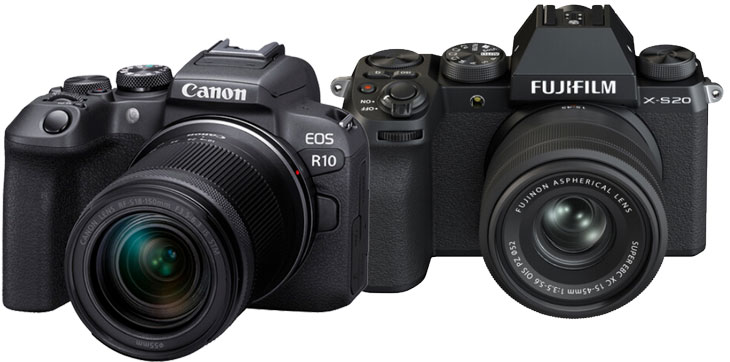
Let’s compare the body design of both cameras. Both are very well built and made for professional shooters with a very deep hand grip and EVF. They are paired up with a variable-angle display screen to give you compositional freedom. Whether you are a photographer or a content creator, you will love the camera’s design.
1. EXTERNAL FAN
The additional advantage we have with the Fuji X-S20 camera is the ability to add an external fan in case of overheating. The external fan will lower the temperature and allow you to record more than double the available recording time.
 With the Fuji X-S20 camera, we are getting dual 3.5 mm ports; one is for headphones and the other is for a microphone. The microphone port can also be used as a remote shutter port. With the Fuji X-S20 camera, we are getting dual 3.5 mm ports; one is for headphones and the other is for a microphone. The microphone port can also be used as a remote shutter port.
2. EXTENDED BATTERY LIFE
We should discuss this in the design part. We have a larger battery in the Fuji X-S20 camera. The battery allows you to capture approximately 700-800 Liveview shots in a single charge, which is double when compared to the battery life of the Canon R10 camera.
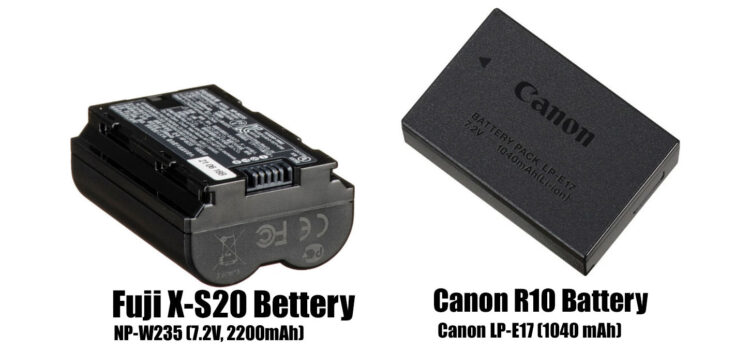

3. VLOG MODE
In vlog mode, we have a dedicated vlog mode in the camera. When you switch the mode dial button to vlog, a new content creator menu pops up. In the content creator menu, you will see 6 different blocks with different modes, including product showcase mode and face tracking priority mode made only for content creators. No content creator or cinematic menu is present in Canon R10.

Let’s talk about the internal core specification of the camera
4. SENSOR
Sensor: The Fujifilm X-S20 camera features Fuji’s popular 26-megapixel sensor. The sensor is a BSI CMOS sensor, not an FSI CMOS sensor like that of Canon R10. So while having a BSI CMOS sensor, we do expect better low-light performance with the Fujifilm X-S20 camera.
Let’s have a look at a quick high ISO test between the two. A sample captured at ISO 25600 of a Canon R10 and Fuji X-S20 camera clearly shows the advantage of having a BSI CMOS sensor while capturing images in low light.
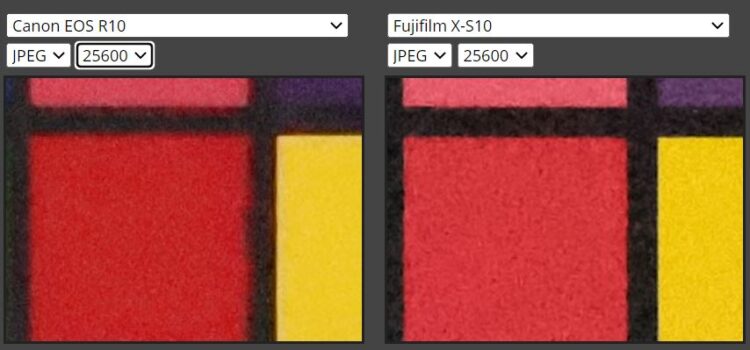
From the high ISO test, it is very clear that Canon is not able to preserve the color details at high ISO range when compared to a Fuji sensor.
The next is autofocusing performance. Both Fuji and Canon are using their latest generation of image processors

5. IMAGE STABILIZATION
In the Fujifilm X-S20 camera, we are getting sensor-shift image stabilization system up to seven stops. Not only that, for the first time in a Fuji camera, we have a dedicated menu to adjust the image stabilization setting according to our needs. No sensor-shift image stabilization system is present in the Canon R10 camera
6. BURST MODE
The next visible difference between these two cameras is the burst speed or the continuous shooting speed. With the Canon R10 camera and its 24-megapixel resolution, you can achieve a burst speed of up to 24 frames per second. With the Fujifilm X-S20 camera, the maximum burst speed available is 30 frames per second with crop and without crop at full resolution up to 20 frames per second.
While using the mechanical shutter, the Canon R10 allows you to capture 12 frames per second and the Fuji X-S20 camera allows you to capture 8 frames per second.
Buffer memory of Fuji X-S20 camera is more compared to Canon R10, its clearly visible in the table below.
| |
Fuji X-S20 |
Canon R10 |
| 10 FPS |
1000+ JPG — 341 RAW |
|
| 15 FPS |
|
460 JPG — 29 RAW |
| 20 FPS |
256 JPG — 79 RAW |
|
| 23 FPS |
|
70 JPG — 21 RAW |
| 30 FPS (1.25x crop) |
407 JPG — 88 RAW |
|
7. AUTO-FOCUSING SYSTEM
Canon R10 arrives with its popular second-generation dual pixel CMOS autofocusing sensor and more than 5000 autofocusing points fabricated inside the sensor. Furthermore, the camera uses 3700 DPAF points while recording video. To simplify it for its users, Canon grouped the points into 651 autofocusing zones.
Now, the Fujifilm X-S20 camera may not be able to match the number of DPAF points, but for the first time, it uses the most advanced artificial intelligence tracking system available inside Fuji. Fujifilm engineers directly used the artificial intelligence AI algorithm of the Fuji X-H2S camera in the Fuji X-S20. This AI enhances the overall performance of the camera and now the camera is even able to track moving drones and insects without an issue. The X-S20 now also features product showcase mode and face AF tracking priority mode.
So more or less both of these cameras have their own advantages and disadvantages when it comes to autofocusing performance.
8. VIDEO
The Fujifilm X-S20 camera is able to shoot 6.2K open gate in 3:2 format at the rate of 30 frames per second. So that’s the maximum resolution available in the Fujifilm X-S20. Now when you want to record in a standard format, that is in 16:9, the resolution drops to 5.2K. So that’s the maximum standard resolution available inside the Fujifilm X-S20 camera. None of these high-resolution modes are available in Canon R10.
The Fuji X-S20 camera is able to record uncropped 4K 60p video as well as full HD videos at the rate of 240 frames per second. Canon R10 fails to impress us as we have to face a 1.6x crop while recording 4K 60 frames of video. At the same time, only a 120 frames per second option is available at full HD format inside Canon R10.

And the biggest difference that will shock you is that no C-Log format is available. Yes, you are able to record 10-bit only in HDR PQ mode in Canon R10, whereas in the Fujifilm X-S20 cameras F-Log and F-Log 2 are both available. In F-Log 2 curve, you are able to extract 13+ stops of dynamic range and at the same time, a 12-bit raw output is available via the HDMI port.

For content creators, we have a dedicated content creator menu and again dedicated autofocusing modes. Not only that but the advanced cinematography and content creation are being backed by the sensor-shift image stabilization of the camera.
For super cinematographers, content creators, and wedding videographers, the Fuji X-S20 camera is the best choice.
So for cinematographers containing creators and wedding video graphs for Fuji x as 20 cameras is the best choice

9. LENSES
Fujifilm X-mount is an open mount and we have a huge range of lenses available and more are coming. At the same time, the Canon RF mount is a locked mount and has a very limited range of lenses available for the APS-C range. If you move towards the DSLR lenses, then you have to be very careful while picking them up since the lenses with STM motors are fully compatible and the older lenses with USM motors will create noise, and not all of them are optimized for dual pixel CMOS autofocusing sensor
10. PRICE DIFFERENCE
We do have a good price difference between these two cameras. If you are on a very tight budget and not able to spend extra on lenses, then you may stay with the Canon R10 camera. But if your budget allows, I highly recommend you to get the Fujifilm X-S20
Fuji Film X-S20 – Camera $1299 [Body Only B&H] [Amazon.com] | 15-45mm Lens $1399 [B&H Store] [Amazon.com]
Canon R10 – Camera body $879 [B&H Store] [Amazon.com] | 18-45mm Lens [B&H Store] [Amazon.com]
|
KEEP THIS BLOG ALIVE - Support New Camera Buy Canon Lenses, Buy Music CD or Digital Camera at amazon it helps this site, and you do not pay anything extra, it is just a way to help support this site.

|
























